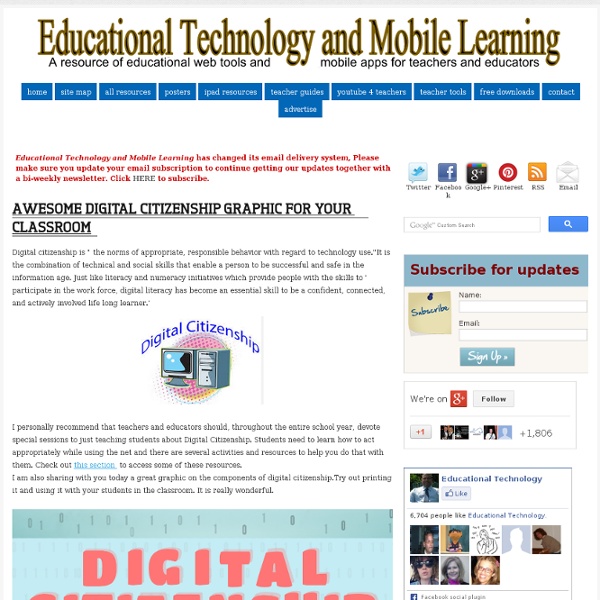Digital footprint
One of the great things about being online is the ability to share videos and photos with your friends and seeing their response. Everything you post online combines to make your digital footprint. Remember that what you share with your friends may also be viewed by people you don’t know. And once it’s online, it could be there forever. So think before you post. You can manage your digital footprint by: Keeping your personal details private. Need to talk? Has something happened online that makes you feel uncomfortable, scared or sad? Talking to friends and family can help.
Digital Literacy and Citizenship Curriculum – Know your web – Good to Know – Google
At Google we believe in the power of education and the promise of technology to improve the lives of students and educators -- leading the way for a new generation of learning in the classroom and beyond. But no matter what subject you teach, it is important for your students to know how to think critically and evaluate online sources, understand how to protect themselves from online threats from bullies to scammers, and to think before they share and be good digital citizens. Google has partnered with child safety experts at iKeepSafe, and also worked with educators themselves to develop lessons that will work in the classroom, are appropriate for kids, and incorporate some of the best advice and tips that Google's security team has to offer. Class 1: Become an Online Sleuth In this class, students will identify guidelines for evaluating the credibility of content online. We are always looking to improve these classes.
Nine Elements
Nine Themes of Digital Citizenship Digital citizenship can be defined as the norms of appropriate, responsible behavior with regard to technology use. 1. Digital Access: full electronic participation in society. Technology users need to be aware that not everyone has the same opportunities when it comes to technology. 2. 3. 4. 5. 6. 7. 8. 9. Respect, Educate and Protect (REPs) These elements have also been organized under the principles of respect, educate and protect. Respect Your Self/Respect Others - Etiquette - Access - Law Educate Your Self/Connect with Others - Literacy - Communication - Commerce Protect Your Self/Protect Others -Rights and Responsibility - Safety (Security) - Health and Welfare If this was to be taught beginning at the kindergarten level it would follow this pattern: Repetition 1 (kindergarten to second grade) Respect Your Self/Respect Others Digital Etiquette Educate Your Self/Connect with OthersDigital Literacy Protect Your Self/Protect Others Digital Rights and Responsibility
Five-Minute Film Festival: Teaching Digital Citizenship
"Digital citizenship" is an umbrella term that covers a whole host of important issues. Broadly, it's the guidelines for responsible, appropriate behavior when one is using technology. But specifically, it can cover anything from "netiquette" to cyberbullying; technology access and the digital divide; online safety and privacy; copyright, plagiarism, and digital law, and more. In fact, some programs that teach digital citizenship have outlined no less than nine elements that intersect to inform a well-equipped digital citizen. It's an overwhelming array of skills to be taught and topics to explore. But while there is much talk about the importance of teaching digital citizenship in this information society, not many are sure what that really looks like. Video Playlist: Teaching Digital Citizenship Watch the player below to see the whole playlist, or view it on YouTube. What is Digital Citizenship? More Resources for Learning About Digital Citizenship
THINK Poster
The Carnegie Cyber Academy - An Online Safety site and Games for Kids
THINK Poster
Basic Internet Safety
Learning to recognize the warning signs of these risks will allow trusted adults to intervene and lessen potential negative impacts. By acting as a resource, parents and guardians can help make the Internet a safer place for their families. As a parent or guardian, you should stay well-informed about current issues to understand what your children are experiencing on and off the Internet. If they are social networking, instant messaging, using webcams, or blogging, help them use these tools safely by learning how to use them yourself. [1] Cox Communications Inc.
Online Reputation Infographic
You don't have to be running for president to care about your online reputation. Almost everything you do online is easy to track, especially when you're using social media sites. This infographic shows you how to manage your "e-reputation," perhaps saving you some embarrassment, or even your career. Gathered by digital marketing firm KBSD, it's a treasure trove of tips, techniques and information about what companies and individuals are looking for inside your personal profiles and social information, and what you can do to show off your best side to those who might want to find out unflattering things about you. So now that you've grown up (you have grown up, haven't you?) Infographic courtesy KBSD, photo courtesy iStockphoto/Yuri Arcurs
Junior Poster
Sharing Photo Poster
Cyber Safety Tips
Thanks to our friends at Family Lives in the UK, they have provided us with this great Cyber Safety Tips Fact Sheet! I hope you find this information helpful! You can learn more about Family Lives by visiting them online here. Cyber Safety Tips Facts Cyberbullying is when a person uses the internet, through various mediums such as computers, phones, tablets, etc. to threaten, tease or embarrass another individual. Even though the bullying might not cause physical pain, the emotional effects can be devastating. Never give out your address or personal details.Remember on Twitter everything you say can be open to the world.Never give out your password.Also be extra careful when you sign into Twitter through other websites.Think before you Tweet! We hear a lot of complaints about stolen identity. Anyone who makes threats to you on the internet could be committing a criminal offense. It’s tempting to have a go back if someone makes a rude posting on your web space but don’t!!



